| dc.description.abstract | The Borana cattle in northern Kenya and southern Ethiopia have unique traits that make them
suitable for the harsh environment in the lowlands and have ever been part of the pastoralists’
identity. Almost all the traditional and cultural rites of the pastoralists in these areas revolve
around the Borana cattle, which are also the main source of their income. However, genetic
erosion of this cattle breed has been occurring at unabated rate due to lack of incentives for
conservation and driving factors such as population pressure, ecological changes, natural
catastrophes and adverse economic conditions. This depletion contributes immense threats to the
livelihoods of the local pastoral communities. Thus conservation efforts of these important
animal genetic resources (AnGRs) by governments and other stakeholders would ensure not only
the well-being of the pastoralists but also prevent losses in genetic materials for future use.
At the moment, there are no compensatory mechanisms targeting pastoralists although exports of
Borana cattle genetic materials to developed countries such as USA and Australia has been
growing. There is also no documentary evidence that pastoralists do share benefits from such
exports. Thus, this paper addresses the following questions: what kinds of pastoralists, due to
their involvement in conservation, deserve compensation and how much should be the level of
compensation?
The empirical data analysed in this paper was collected from Borana pastoralists in Ethiopia. The
magnitude of compensation payments is derived from the costs that pastoralists incur for
maintaining only Borana cattle in their herds. These costs include costs for not keeping other
breeds which are probably more economically attractive (opportunity costs), as well as
transaction costs. Finally, several policy implications for community-based conservation of
Borana cattle are derived. | en |

